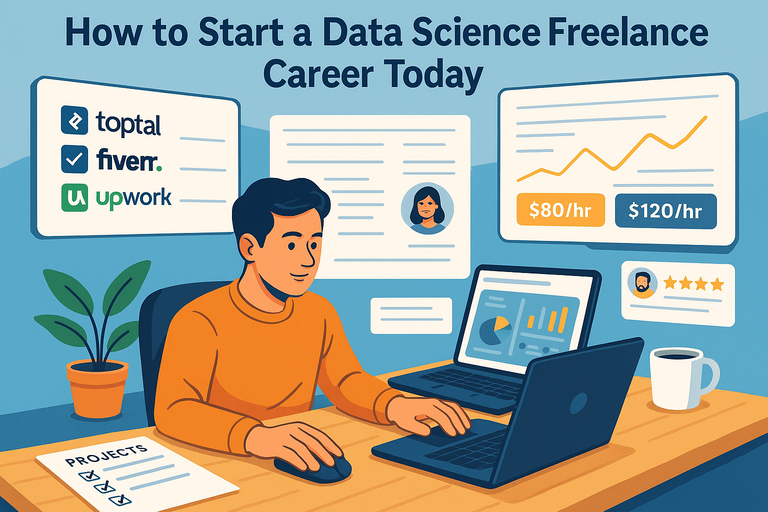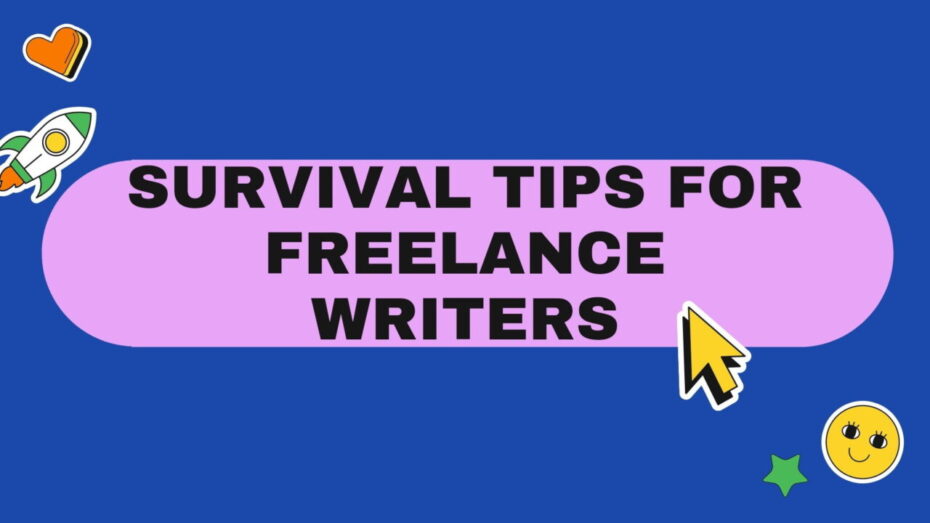Table of Contents
Starting a data science freelance career might sound thrilling—but also a little intimidating. Where do you even begin when the world of algorithms, clients, and competition feels endless?
The truth is, freelancing in data science isn’t just for experts with decades of experience; it’s for anyone ready to apply their analytical skills to real-world problems while working independently.
In this guide, you’ll learn exactly how to launch your freelance journey today—what skills to sharpen, where to find clients, and how to build credibility fast. Ready to find out how to turn your data skills into income?
Let’s dive in.
Understanding What a Data Science Freelance Career Really Is
Freelancing in data science means you get to apply your analytical brain to solve real business problems—without being tied to a single employer.
It’s about flexibility, self-direction, and using data skills to create value for multiple clients instead of one company.
The Role of a Freelance Data Scientist
A freelance data scientist helps businesses make better decisions using data. Unlike traditional employees, freelancers work on short-term or project-based contracts.
One week you might be cleaning messy e-commerce data, the next you’re building a churn prediction model for a fintech startup.
Think of your role as a problem solver who moves between projects, adapting to each client’s needs. Some tasks include:
- Data cleaning and preprocessing: Fixing missing values, normalizing data, or converting raw data into usable form.
- Model development: Building predictive models using Python libraries like Scikit-learn, TensorFlow, or PyTorch.
- Visualization and reporting: Creating dashboards in Power BI or Tableau that make insights digestible for non-technical stakeholders.
I believe the best freelancers act as translators between raw data and business value—turning numbers into narratives that executives understand.
How Freelance Work Differs From Full-Time Data Science Jobs
The biggest difference? Freedom versus structure.
In a corporate setting, your work might be part of a long pipeline—data engineers, analysts, and product teams all feeding into each other. As a freelancer, you often wear multiple hats: data scientist, communicator, and sometimes even project manager.
- You control your workload: You can take on two clients or ten—it’s your choice.
- You set your rates and scope: No HR department, no salary band. You negotiate directly.
- You own your growth: Learning new skills and tools is self-directed.
Freelancers trade stability for autonomy. But in return, they gain variety, learning speed, and often, better pay per project.
Common Types of Freelance Data Science Projects
From what I’ve seen, freelance data science work falls into a few main categories:
- Data analysis and visualization: Cleaning data, identifying trends, and presenting insights.
- Machine learning model development: Predicting sales, user churn, or customer behavior.
- Automation scripts: Writing Python scripts to streamline repetitive business processes.
- Dashboard creation: Designing visual tools in Power BI, Tableau, or Looker.
- Data consulting: Advising companies on how to structure their data or build an analytics team.
Example: I once saw a freelancer use Google Colab + Streamlit to build a quick customer segmentation tool for a marketing agency—simple, but incredibly effective.
What Companies Look for When Hiring Freelance Data Scientists
Clients don’t just want technical skills—they want results. Companies typically seek freelancers who:
- Understand the business problem before jumping into code.
- Can communicate findings in plain language.
- Deliver high-quality work on time and with minimal oversight.
- Have a proven record of relevant projects (your portfolio matters more than your degree).
If you can explain how your model increases revenue or saves costs, you’ll stand out instantly.
Building the Right Skill Set for Freelance Success
To thrive in the data science freelance world, you need more than Python and Pandas. You need a combination of technical depth, business understanding, and client communication skills.
Core Technical Skills Every Freelance Data Scientist Needs
Here’s what most clients expect:
- Python or R: For data analysis, automation, and model building.
- SQL: To extract and query data from databases.
- Statistics & Probability: To understand model behavior and test hypotheses.
- Machine Learning: Regression, classification, clustering, and model evaluation.
- Visualization Tools: Power BI, Tableau, or Plotly for dashboards.
I suggest creating small, reusable project templates (e.g., an end-to-end regression pipeline) that speed up future work.
The Most In-Demand Tools and Programming Languages
The tools you’ll use depend on client preferences and project type. Here’s what’s trending in 2025:
- Python (NumPy, Pandas, Scikit-learn, PyTorch)
- SQL (PostgreSQL, BigQuery, MySQL)
- Cloud platforms: AWS Sagemaker, Google Cloud AI, Azure ML
- Visualization: Power BI, Tableau, Streamlit
- Collaboration: GitHub, Jupyter, VS Code
Example workflow: From your AWS Console, go to SageMaker > Notebook Instances > Create Notebook, and use that environment for scalable model training.
Why Communication and Business Acumen Matter More Than You Think
Freelancers succeed when they bridge the gap between technical insights and business decisions.
You might build the perfect model—but if the client doesn’t understand why it matters, your impact is lost. That’s why soft skills like storytelling, presentation, and negotiation matter just as much as technical prowess.
Try this simple structure when delivering results:
- The problem: What business pain are you solving?
- Your approach: Brief overview of your data and model.
- The results: Quantify improvements (e.g., “Improved forecast accuracy by 12%”).
- Next steps: Actionable insights for the client.
How to Stay Competitive Through Continuous Learning
Data science evolves fast. Staying relevant means committing to lifelong learning.
Here’s what I recommend:
- Follow trends: Platforms like KDnuggets or Towards Data Science highlight emerging tools.
- Join communities: Engage on Kaggle, Reddit’s r/datascience, or Discord servers.
- Take micro-courses: Coursera, DataCamp, or DeepLearning.AI for quick, applied learning.
- Experiment constantly: Build side projects to test new methods.
Learning isn’t optional—it’s the engine that keeps your freelance business alive.
Creating a Strong Freelance Portfolio That Wins Clients
Your portfolio is your digital handshake—it tells clients what you’ve done, how you think, and whether they can trust you. A polished portfolio can replace years of experience.
How to Build Projects That Showcase Real-World Impact
Clients love projects that show measurable results. Instead of generic “Titanic dataset” notebooks, pick problems businesses actually face.
Example project ideas:
- Predicting marketing ROI for small businesses.
- Detecting fraudulent transactions using anonymized data.
- Automating customer segmentation with clustering.
Include before-and-after metrics (like “Reduced churn prediction error from 25% to 10%”). It signals real value.
Using GitHub and Kaggle to Strengthen Your Portfolio
Your GitHub is more than a code dump—it’s your professional showcase. Structure it like this:
- README.md: Explain each project’s goal, methods, and outcomes.
- Notebooks: Clean, commented, and reproducible.
- Results folder: Include charts or summaries for quick skimming.
Kaggle, on the other hand, shows your competitiveness and problem-solving creativity. Even a few top-50% rankings can strengthen your credibility.
Crafting Case Studies That Highlight Problem-Solving Ability
Case studies turn data projects into business stories. A good case study includes:
- The challenge: Define the problem clearly.
- The process: Walk through your data cleaning, feature selection, and modeling steps.
- The outcome: Include key metrics or visuals that prove success.
- The takeaway: Share what you learned or how it benefited the client.
I advise writing these in plain English—imagine you’re explaining to a non-technical manager.
Designing a Personal Website That Reflects Professional Credibility
A website makes you look legitimate—and it’s surprisingly easy to build. You can use Notion, Webflow, or GitHub Pages.
Include:
- Your bio and niche focus.
- Portfolio projects with case study links.
- Contact form and social media links.
- A short blog sharing your thoughts on data topics.
Think of your site as your always-on salesperson—showing your best work while you sleep.
Setting Up Your Freelance Business the Right Way
Before you dive into finding clients, take a step back and set up your freelance business properly. It’s the foundation that helps you look professional, get paid on time, and avoid headaches later.
Choosing the Best Freelance Platforms for Data Science Work
If you’re just starting, joining a freelance platform can give you visibility and credibility fast. The key is to pick platforms that value expertise—not just low-cost bids.
Top Platforms for Data Science Freelancers:
- Toptal: Curated network of elite freelancers. You’ll need to pass a screening test, but clients here pay premium rates.
- Upwork: Great for beginners. You can start small with data cleaning or visualization gigs, then move toward machine learning projects.
- Freelancer.com: Good for volume but more competitive. Filter projects under “Data Science” or “Machine Learning.”
- Kolabtree: Specializes in scientific and analytical freelancers—perfect for academic or biotech projects.
- LinkedIn Services Marketplace: A great free option to showcase your expertise and let clients come to you.
Pro tip: Create a profile that highlights your results, not just your skills. Instead of saying “Proficient in Python,” say “Helped a SaaS startup cut churn by 18% using predictive analytics.”
How to Set Competitive and Fair Pricing for Your Services
Pricing in freelance data science isn’t guesswork—it’s strategy. The right rate reflects your experience, skill level, and value to the client.
Here’s a practical way to decide:
- Check the market average: Data scientists on Upwork charge anywhere from $40 to $150/hour.
- Calculate your baseline: Add up monthly expenses + taxes + savings goals, then divide by billable hours.
- Value-based pricing: For project work, charge based on outcome (e.g., “$2,000 for building a sales prediction model”).
I suggest starting slightly below your ideal rate to attract early clients—then raise it as your portfolio grows.
Example: A data visualization project that takes 15 hours at $75/hour = $1,125. Add a 10% buffer for revisions.
Writing Proposals That Get Client Attention
The secret to winning freelance projects? Personalization. Clients can smell a template from a mile away.
Here’s a structure I use for writing proposals:
- Start with empathy: Show you understand their problem. (“I noticed you’re looking for someone to forecast sales trends. I’ve worked on a similar project for a retail client…”)
- Explain your approach briefly: (“I’d clean and analyze your data in Python, then visualize the results using Power BI.”)
- Show relevant proof: Link to a GitHub project or a short portfolio case study.
- End with clarity: Set expectations for next steps or timelines.
Avoid: Long introductions or repeating your resume. Clients care about how you’ll solve their issue, not your entire history.
Setting Up Contracts, Invoices, and Payment Systems
Freelancing isn’t just about doing great work—it’s about getting paid for it smoothly.
- Contracts: Use templates from Bonsai,Dropbox Sign, or DocuSign. Include scope, deliverables, and payment terms.
- Invoices: Tools like FreshBooks or QuickBooks make it easy to send branded invoices and track payments.
- Payment systems: Most freelancers use PayPal, Wise, or Stripe for global clients.
A good habit: Always request a 30–50% upfront deposit. It protects you from no-shows and shows client commitment.
Finding Your First Clients and Building Long-Term Relationships
Getting your first few clients is often the toughest part—but once you build momentum, referrals and repeat business become your biggest growth engine.
Proven Strategies to Get First Freelance Clients Fast
If I had to start over today, here’s exactly what I’d do:
- Start small but visible: Offer a few projects on Upwork or Fiverr to get initial reviews.
- Leverage your network: Message former classmates, coworkers, or LinkedIn contacts. Let them know you’re taking on freelance data projects.
- Post your projects online: Share a quick thread like “How I predicted e-commerce demand using Python” on LinkedIn or X (Twitter).
Small wins build credibility fast. Even one $300 visualization project can open doors to bigger clients.
How to Network in the Data Science Community Effectively
Networking doesn’t mean awkward small talk—it means showing genuine curiosity and sharing value.
Practical networking tips:
- Join Discord or Slack groups like DataTalks.Club or Analytics Vidhya.
- Attend virtual meetups or hackathons. They’re full of potential collaborators and clients.
- Engage on LinkedIn posts—don’t just like, but comment with insight (“I’ve seen similar results when cleaning time-series data with Prophet.”).
I’ve met clients simply by being active in Kaggle forums. People remember helpful contributors.
Using LinkedIn, Twitter, and Reddit to Find Opportunities
These platforms are gold mines for freelancers—if you know how to use them strategically.
- LinkedIn: Optimize your headline (“Freelance Data Scientist | Predictive Modeling & AI Automation”). Post weekly about projects, insights, or tools.
- Twitter/X: Follow and interact with data influencers and company founders. Use hashtags like #DataScienceJobs or #FreelanceDataScientist.
- Reddit: Subreddits like r/datascience, r/freelance, or r/remotework often feature short-term project listings.
Example workflow: From LinkedIn’s homepage, click “Jobs” → “All filters” → under “Job type,” select “Contract” or “Freelance.”
Turning One-Off Projects into Recurring Clients
Long-term success in data science freelancing comes from relationships, not transactions.
To turn clients into repeat customers:
- Deliver early and exceed expectations.
- Schedule short “post-project check-ins.” Ask how your solution is performing.
- Suggest next steps—like additional automation or model updates.
For example, a freelancer who builds a client’s sales dashboard could later offer monthly maintenance or quarterly analytics reviews. This builds consistent income without new client hunts.
Managing Projects and Delivering High-Value Results
Once projects start rolling in, your next challenge is juggling deadlines, expectations, and revisions—while maintaining quality.
Best Practices for Communicating With Clients Clearly
Clear communication is your best tool for happy clients and repeat work.
Here’s a simple rhythm I recommend:
- Kickoff call: Define deliverables and success metrics.
- Weekly updates: Send a short summary email (“This week I cleaned data, built the initial model, and tested accuracy”).
- Final delivery: Include a concise handover note and documentation.
Avoid jargon unless necessary. Instead of saying “applied logistic regression with L2 regularization,” try “built a classification model to predict customer churn.”
How to Manage Timelines, Scope, and Expectations
Scope creep—when clients keep adding tasks—is the freelancer’s silent killer.
To prevent it:
- Define clear milestones in your contract.
- Use tools like Trello to track tasks.
- Communicate changes early: “Adding this feature will take an extra two days and cost $150 more.”
Transparency keeps trust intact and protects your time.
Tools That Simplify Freelance Data Science Project Management
You don’t need an enterprise system—just the right mix of lightweight tools:
- Trello or Notion: For organizing deliverables and deadlines.
- Google Drive / Dropbox: For sharing datasets and results.
- Slack or Discord: For quick client communication.
- GitHub: For version control and code handover.
Example workflow: In Trello, create columns “To Do,” “In Progress,” “Review,” and “Completed.” Move cards through as you hit milestones.
Handling Revisions and Feedback Professionally
Revisions are part of freelancing—it’s how you turn good work into great work.
When clients request changes:
- Listen without defensiveness.
- Clarify what’s needed. (“Do you mean changing the visualization type or the data filter?”)
- Estimate extra time if it’s beyond scope.
- Deliver promptly and thank them for the feedback.
A calm, professional response builds trust and often leads to more work.
Growing Your Data Science Freelance Brand
At some point, you’ll realize freelancing isn’t just about finding projects—it’s about becoming known for what you do best.
Your personal brand is what transforms you from “just another freelancer” into the go-to expert clients seek out (and pay more for).
Building a Personal Brand That Attracts High-Paying Clients
A strong personal brand tells clients exactly who you help, what you do, and why they should trust you.
Here’s how I suggest building it:
- Define your niche: Are you the go-to person for machine learning in finance? Or visualization for healthcare data? A clear niche attracts serious clients.
- Create consistent messaging: Use a one-liner that captures your value, like “I help startups use data to predict customer behavior.”
- Show up online: Post insights on LinkedIn, write short tutorials on Medium, or share mini project breakdowns on X (Twitter).
Example: Share a post like “How I increased a retail client’s forecasting accuracy by 15% using Prophet.” It’s short, specific, and shows expertise.
Pro tip: Update your LinkedIn “About” section with client-centered language—speak to their problems, not just your background.
How to Use Content Marketing to Build Authority
You don’t need a massive audience to build credibility—just consistent, helpful content.
I recommend starting small:
- Write about real problems you’ve solved (“How I cleaned 1 million rows of messy data in under an hour”).
- Share short video walkthroughs of data projects or dashboards.
- Contribute to open-source projects and write case summaries.
If you’re using tools like Medium or Substack, aim for content that blends education + demonstration. For instance:
- “How to Automate Excel Reports With Python in 5 Minutes”
- “The Simple Visualization Trick That Helped My Client Identify a $30K Revenue Gap”
Each piece of content becomes a quiet salesperson working for you, showing your expertise without needing a hard pitch.
Leveraging Client Testimonials and Referrals
One testimonial is worth more than a thousand cold emails.
After each successful project, politely ask your client for feedback. A simple request like, “Would you mind sharing a few lines about your experience working with me?” works perfectly.
Then, showcase testimonials on your website, Upwork profile, or LinkedIn recommendations.
Referral Tip: Offer incentives for referrals, like a small discount on future work or a free consultation session. Most satisfied clients are happy to recommend you—they just need a little reminder.
I’ve personally seen referrals snowball: one happy client in fintech referred me to three others without me even asking. Word-of-mouth is pure gold.
Expanding Into Consulting or Creating a Micro Agency
Once you’ve got a steady stream of clients, it might be time to scale beyond solo freelancing.
You have two paths:
- Consulting: Position yourself as a strategic partner rather than a task executor. Focus on problem discovery, not just code delivery.
- Micro agency: Build a small team (2–5 freelancers) who complement your skills—maybe one data engineer, one visualization expert, one analyst.
Use tools like Slack or ClickUp to collaborate smoothly.
Example path: You land a dashboard project → You handle the modeling, your partner handles front-end visuals → You deliver faster and charge more.
This is how freelancers evolve into businesses.
Overcoming Common Freelancing Challenges in Data Science
Every freelancer—no matter how skilled—hits roadblocks. The secret isn’t to avoid them, but to manage them like a professional.
How to Handle Periods Without Projects
Feast-and-famine cycles are normal, especially early on.
Here’s what I do when work slows down:
- Keep learning: Use downtime to explore new tools (like LangChain or Power BI updates).
- Reach out: Email old clients asking if they need updates on previous projects.
- Create content: Share what you’re learning—visibility often turns into leads.
- Pitch proactively: Don’t wait for jobs to come to you. Send personalized proposals to companies who could benefit from your expertise.
Consistency beats panic. Treat slow months as an investment phase, not a failure.
Managing Burnout and Maintaining Work-Life Balance
Freelancers often forget they’re humans, not data machines.
If you’re working 12-hour days, it’s not sustainable. I suggest setting:
- Boundaries: Choose your working hours and communicate them clearly.
- Mini-breaks: Even 10 minutes of walking or stretching resets your brain.
- Weekly reviews: Reflect on what’s working and what isn’t.
Remember, your brain is your business’s most valuable asset. Protect it.
Dealing With Difficult Clients and Payment Issues
At some point, you’ll encounter a client who demands “one more change” or delays payment.
Here’s how to stay calm and in control:
- Document everything: Keep all project terms in writing.
- Set payment milestones: For example, 30% upfront, 40% mid-project, 30% on completion.
- Stay polite but firm: “I’d love to continue, but that would fall outside our original scope. I can provide an updated quote.”
If payment issues arise, use Escrow systems (like Upwork’s) or payment tools like Stripe that offer protection for freelancers.
Staying Motivated When Progress Feels Slow
It’s easy to compare yourself to others online. But remember, everyone’s timeline is different.
I suggest keeping a “win log”—a simple list of accomplishments, big or small. Things like “finished my first client project” or “learned SQL joins today.”
Progress compounds quietly. Freelancing rewards patience, not perfection.
Expert Tips to Scale Your Freelance Data Science Career
Once you’ve mastered the basics and built momentum, it’s time to think bigger. Scaling is about increasing impact—without increasing burnout.
When and How to Raise Your Rates
Here’s a simple rule I follow: Raise your rates when demand exceeds your capacity.
If clients keep saying yes immediately, your pricing might be too low.
How to do it smoothly:
- Inform existing clients politely: “Starting next month, my rates will be increasing to reflect the added value I provide.”
- For new clients, simply quote higher—no explanation needed.
- Consider shifting to project-based pricing (e.g., $2,000 per model deployment) instead of hourly rates.
It’s not about charging more for the same work—it’s about charging appropriately for the expertise you’ve built.
Creating Scalable Income Streams With Data Products
Freelancing earns you active income, but you can also create passive revenue through products.
Ideas that work:
- Online courses or eBooks: Teach a niche skill (“Building Forecast Models With Python”).
- Data templates or dashboards: Sell ready-to-use models or Power BI dashboards.
- Micro-consulting calls: Offer 30-minute paid sessions for quick problem-solving.
I’ve seen freelancers turn one-off Jupyter notebooks into products on Gumroad—it’s smart recycling of your expertise.
Collaborating With Other Freelancers or Small Teams
Collaboration is the fastest way to grow your service capacity.
Form a network of specialists you trust: data engineers, visualization experts, or ML ops specialists. When a big project lands, you can deliver faster and with more polish.
Use Notion or Trello for project coordination, and Slack for real-time updates.
Collaboration not only lightens your load—it expands your reputation.
Setting Long-Term Goals for Professional Growth
It’s easy to get caught in the short-term project grind. Set goals that guide your direction.
Think in 3 horizons:
- 6 months: Build portfolio depth and client consistency.
- 1 year: Refine your niche or launch a personal data blog.
- 3 years: Transition into consulting or build a small team.
Revisit these goals quarterly. Growth in freelancing is iterative—built through small, deliberate upgrades.
Final Steps to Launch Your Data Science Freelance Career Today
Now that you’ve got the blueprint, the only thing left is action. Start small, stay consistent, and iterate.
Crafting an Action Plan for Your First 30 Days
Here’s a practical 30-day roadmap to get started:
- Week 1: Build or polish your portfolio (3 projects minimum).
- Week 2: Set up LinkedIn, Upwork, and your personal website.
- Week 3: Apply for 10 targeted gigs and start networking.
- Week 4: Land your first client or project—even a small one counts.
Momentum matters more than perfection.
Building Habits That Keep You Productive and Consistent
Freelancing rewards discipline. Some habits that changed my workflow:
- Use time blocking to focus on deep work.
- End each day with a quick reflection: “What did I learn? What will I do tomorrow?”
- Keep communication logs for every client.
Small daily habits compound into massive professional growth.
Why Experimentation and Persistence Are Your Best Allies
Freelancing in data science isn’t a straight path—it’s an ongoing experiment. Some proposals will fail. Some projects won’t go as planned. That’s normal.
I believe the freelancers who succeed are those who keep experimenting—trying new tools, testing new pricing, learning from mistakes.
Persistence builds reputation. Reputation builds income.
Quick Checklist to Get Started Immediately
- Polish your portfolio and LinkedIn profile.
- Join at least one freelance platform.
- Create a clear pricing structure.
- Reach out to your network for your first project.
- Commit to learning one new tool every month.
If you take even one small action today—send that proposal, post that project, or reach out to that connection—you’re already ahead of most people who just think about freelancing.
Your data science freelance career doesn’t start when you’re “ready.”
It starts when you begin.






